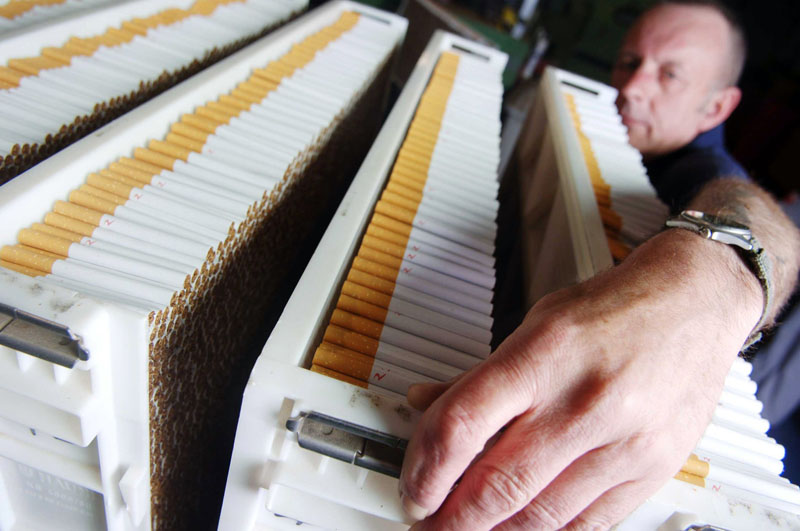British American Tobacco’s cigarette volumes during 2015, at 663 billion, were down by about 0.5 percent on those of 2014, 667 billion.
Excluding the additional volume provided by the acquisition of TDR, Croatia, the ‘organic’ decline was said to be about 0.8 percent.
But even the organic decline was modest when set against what BAT estimated was the industry decline: 2.3 percent.
The company’s cigarette volumes were increased in its EEMEA (Eastern Europe, Middle East and Africa) region from 227 billion to 229 billion, and in its Asia Pacific region from 197 billion to 198 billion; they were unchanged in its Western Europe region at 112 billion; but they were down in the Americas from 131 billion to 124 billion.
The decline in cigarette volume was said to have been largely due to market contraction in Brazil, Italy, Russia, Pakistan, Malaysia and South Korea, which was partly offset by higher group volume in Turkey, Bangladesh, Iran, Kazakhstan, Ukraine and Denmark.
The group increased market share by more than 0.4 of a percentage point in its key markets: notably in South Korea, Indonesia, Russia, Japan, Turkey, France, Pakistan, Bangladesh, Mexico, Malaysia, Ukraine, Kazakhstan and the UK.
This share increase was said to have been driven by what was described as an ‘excellent performance’ by the company’s Global Drive Brands, whose volume increased by 8.5 percent and whose market share grew by 1.2 percentage points.
Dunhill’s market share grew by 0.3 of a percentage point as volume increased by 6.0 percent, driven mainly by market performances in Indonesia and South Africa, offsetting lower volume in the markets of South Korea and Malaysia.
Kent volume grew by 3.3 percent, with market share in line with that of the previous year, as volume growth in Iran, Turkey, Japan and Chile was partly offset by lower volume in Russia and Ukraine driven by market contraction.
Lucky Strike volume was up by 3.6 percent, driven by growth in Belgium, France and Chile offsetting lower volumes in Russia and Argentina and resulting in an improvement in market share of 0.1 of a percentage point.
Pall Mall’s market share also grew by 0.1 of a percentage point with volume higher by 0.4 percent as good performances in Pakistan, Venezuela, Poland and Mexico were partly offset by the ‘migration’ to Rothmans in Italy.
Rothmans’ strong volume growth of 46.5 percent was driven by the markets of Russia, Ukraine, Turkey, Italy, Kazakhstan, Australia, Algeria and the UK, with market share growing by 0.7 of a percentage point.
The volume of other international brands declined by 6.8 percent, as growth in State Express 555 and Shuang Xi were more than offset by lower volumes in Peter Stuyvesant, JPGL, Craven A and Vogue.
Innovations were said to account for more than 26 percent of BAT’s cigarette volume and they were said to have grown in 2015 by 14 percent driven by the success of Tubes, mainly in respect of the Kent brand, and ‘slimmer variants’, particularly those of the Rothmans brand.
BAT’s tobacco volumes during 2015, at 689 billion, were down by about 0.8 percent. Tobacco volumes include, as well as cigarettes, other tobacco products whose volumes are stated in cigarette stick equivalents.
BAT’s revenue, at £13,104 million, was down by 6.2 percent on that of 2014, £13,971 million.
Adjusted profit from operations was down by 7.6 percent to £4,992 million.
Profit from operations was increased by 0.2 percent to £4,557 million.
Adjusted diluted earnings per share were up by 0.1 percent to 208.4p, while basic earnings per share were increased by 38.2 percent to 230.9p.
Dividends per share were up by 4.0 percent to 154.0p.
“We delivered outstanding results in 2015, against a very challenging external environment and with significant adverse transactional foreign exchange rate movements,” said chief executive Nicandro Durante on announcing BAT’s preliminary results.
Turning to the issue of next generation products, Durante said that BAT was confident that such products could deliver a substantial and sustainable commercial return to shareholders over the long term.
“In 2015, we continued to grow market share of Vype, our e-cigarette brand, in the UK where we launched three new products and a range of new e-liquid flavours,” he reported. “We also expanded the geographical footprint of our next generation product business beyond the UK, with launches of Vype in France, Germany, Italy, Poland and Colombia. Additionally, our first Tobacco Heating Product, the ‘glo iFuse’, was launched in Romania with excellent initial levels of consumer acceptance.”
Durante said also that BAT was continuing its R&D focus on building a high quality pipeline of products across three distinct next generation product categories – vapour products (electronic cigarettes), tobacco heating products and licensed medicinal products.
Progress was encouraging, he said, and BAT’s ambition was to lead the next generation product category worldwide.
Watch a video interview with BAT CEO Nicandro Durante









